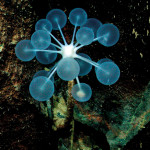
The ocean is a many-layered thing. If you ask a marine biologist to tell you about these ocean layers, they’ll talk about the “photic zone” and the “oxygen minimum zone”. These gradients in light and oxygen influence the type and variety of animals you will find there. But if ask an oceanographer to tell you about layers in the sea, they’ll tell you about “bottom water”, “intermediate water”, and “upwelled Atlantic water”. Precise measurements of temperature and salinity help to discern water mass ‘signatures’. Oceanographers use these signatures to track water masses along a three dimensional global conveyor belt as they converge and diverge around “flow obstacles” like seamounts, ridges, and continental margins. Oceanographers like to talk about water. Animals are the farthest thing from their mind.
Different disciplines obviously have different perspectives and different approaches. Biologists inspire school kids with stories of dolphins and turtles, but oceanographers inspire weathermen with stories of tropical depression and rogue waves. Biologists worry about fisheries, and oceanographers fret about El Nino. Biologists star in “Jaws” and “Seinfeld”, but physical oceanographers star in “The Day After Tomorrow” and “Hunt for Red October”. These disciplines are intertwined, of course. Fish are sensitive to water temperatures, for example, and the water column responds to animal migrations, so it’s important to understand these interactions.
A new report in Geophysical Research Letters suggests that a significant interaction between biology and oceanography is occurring in the Northwest Pacific. Researchers from the neatly monikered Institute of Low Temperature Science at Hokkaido University in Sapporo, Japan are showing that intermediate water (200-2000m) off Russia has warmed significantly over the past 50 years. The warming trend is accompanied by decreasing oxygen content. This suggests to the authors T. Nakanowatari, K.I. Oshima, and M. Wakatsuchi that weaker overturning (vertical exchange) is taking place. The warmer water is attributed to a decrease in (cold) shelf water production in the Sea of Okhotsk, an epicenter of global warming. Warm water and low DO is probably bad news for deep water fisheries targeting high latitude cold water fishes.
This is only the beginning of the problem, however. Recall this deep water warming trend and slowed overturning in the Gulf Stream was the basic premise of the Hollywood doomsday flick “Day After Tomorrow”. The movie was built on a hypotheses by oceanographers (le.g. Wallace Broecker) and climate scientists (e.g. Stefan Rahmstorf , read this in particular) whose work suggests that global warming might slow the global conveyor belt to the point where it shuts down in the North Atlantic, bringing on a new ice age.
The article by Nakanowatari et al (2007) is the “Day After Tomorrow” in a new setting. It’s science imitating art imitating science. Throw in a love triangle and a giant squid and you’ve got yourself a movie. If you want to buy rights to the script, the abstract is here.





